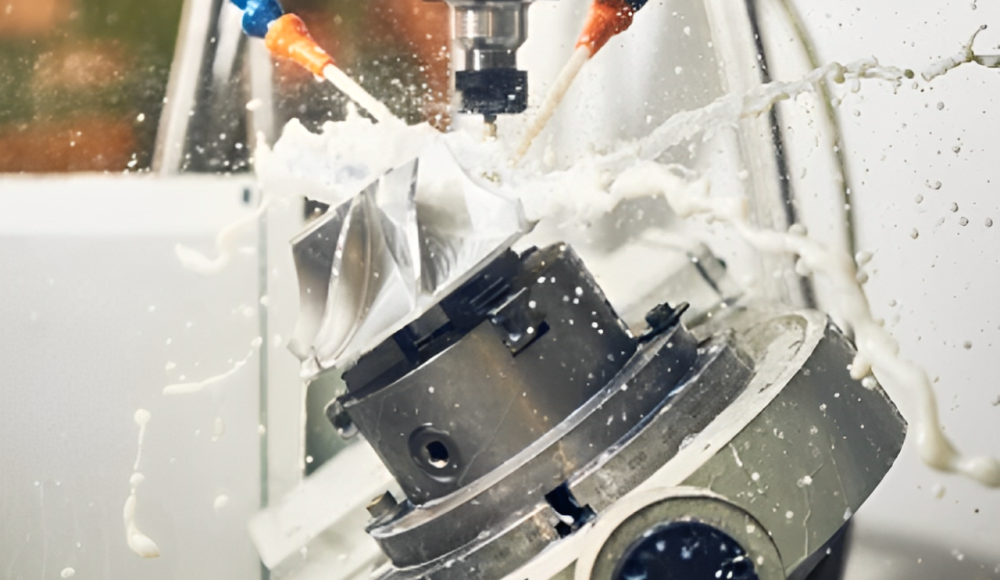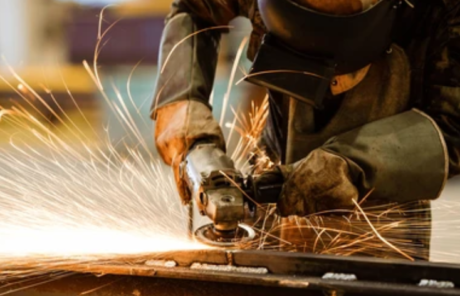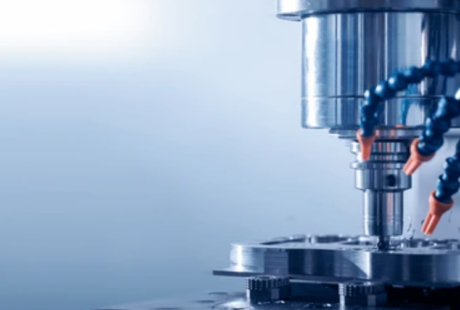A usinagem é uma operação central na fabricação, pois envolve fixar ou remover material de uma peça de trabalho, ou seja. metais para atingir a geometria necessária. CNC é uma das técnicas de usinagem mais utilizadas enquanto a outra é chamada de usinagem manual. Resumidamente, embora cada um tenha suas vantagens com base na complexidade da tarefa, precisão necessária, ou volume de produção, cada um tem sua proposta de valor única. Neste artigo, você aprenderá o que significa usinagem CNC e manual, como eles operam, e suas vantagens e desvantagens.
O que é usinagem CNC?
CNC é Controle Numérico Computadorizado, que é um método no qual uma máquina-ferramenta é operada com a ajuda de um programa de computador para produzir algumas peças com altíssima precisão.. A máquina implanta códigos de programas de computador. Então eles determinam o movimento das ferramentas, velocidade, e taxas de avanço da máquina. A usinagem CNC tem um amplo escopo de aplicações na realização de trabalhos de precisão complexos e repetitivos. Essas indústrias podem incluir a automotiva, aeroespacial, fabricação de eletrônicos, etc..
O que é usinagem manual?
A usinagem manual envolve um operador alimentando e conduzindo as ferramentas de corte nas ferramentas de usinagem, ou seja. tornos, moinhos, e moedores para formar o material. Ao contrário do CNC, a usinagem manual depende principalmente das habilidades e conhecimentos do trabalhador em relação às ferramentas. É predominantemente aplicado durante trabalhos de operação única, trabalhos de reparação, ou para produzir itens que não possuem requisitos de tolerância rigorosos.
Como funciona a usinagem CNC?
O processo de usinagem CNC começa com a definição de um projeto auxiliado por computador ou um modelo CAD da peça a ser usinada. Este modelo é então traduzido para a linguagem de programação CNC, ou seja. Código G que direciona o funcionamento da máquina. Depois que o programa é baixado na máquina CNC pelo computador, um operador configura a máquina CNC, e então o computador assume. A operação de corte ou fresagem ocorre através das instruções deixadas na máquina e poucas correções são necessárias nas peças.
Como funciona a usinagem manual?
Na usinagem manual, mecanicistas operam e controlam as ferramentas manualmente sob seu controle direto. O movimento das ferramentas é sincronizado com a configuração da máquina, ou seja. velocidade, profundidade de corte, e taxa de alimentação, entre outros. O maquinista manipula o trabalho com as mãos controlando as posições das ferramentas de corte. Ele ajuda a formar o material adequadamente. Usinagem manual, por outro lado, tem interações frequentes com os materiais e operações físicas, portanto, envolve mais operações manuais e depende muito da habilidade do trabalhador.
A comparação entre usinagem CNC e usinagem manual
A seguir estão as principais diferenças entre CNC e usinagem manual:
-
Automação
A usinagem CNC automatiza totalmente o processo de usinagem, enquanto na usinagem manual o processo deve ser executado o tempo todo.
-
Precisão
A usinagem CNC é mais precisa do que a usinagem manual. No entanto, em usinagem CNC, as operações são dirigidas por um programa controlado.
-
Complexidade
Projetos complexos podem ser convenientemente projetados para o processo de usinagem CNC, enquanto a usinagem manual é mais adequada para os mais simples..
-
Velocidade
Uma máquina CNC pode fabricar uma peça muito mais rápido quando comparada a uma máquina manual, especialmente quando é uma grande quantidade.
-
Trabalho
A usinagem manual requer muita concentração do operador, enquanto as máquinas CNC precisam apenas de uma pequena entrada inicial e, em seguida, são configuradas para funcionar por conta própria.
-
Custo
As máquinas CNC são inicialmente caras para comprar, enquanto as ferramentas de usinagem operadas manualmente podem ser caras em termos de mão de obra durante a produção em massa..
A tabela a seguir resumirá a principal comparação entre usinagem CNC e usinagem manual:
| Fatores | Usinagem CNC | Usinagem Manual |
| Automação | Totalmente automatizado. | Operação manual por um maquinista. |
| Precisão & Tolerância | Alto: ±0,001″ (±0,025 mm). | Moderado: ±0,005″ (±0,127 mm). |
| Velocidade | Rápido, ideal para grandes volumes. | Mais devagar, depende da habilidade do operador. |
| Complexidade | Ideal para geometrias complexas. | Melhor para designs simples. |
| Volume de produção | Eficiente para grandes tiragens. | Adequado para trabalhos únicos ou de baixo volume. |
| Requisito de mão de obra | Mínimo após configuração. | Alto, requer mão de obra qualificada em todo. |
| Custo por peça | Abaixe para grandes corridas. | Maior devido aos custos trabalhistas. |
| Tempo de configuração | Alto: horas para dias. | Baixo: minutos a horas. |
| Desperdício de Materiais | Baixo, desperdício mínimo. | Maior devido a erro humano. |
| Custo da máquina | Alto: $50,000 para $500,000+. | Mais baixo: $5,000 para $50,000. |
| Nível de habilidade | Requer conhecimento de programação CNC. | Experiência prática em usinagem. |
| Precisão de repetição | Consistente em todas as peças. | Variabilidade devido a ajustes manuais. |
| Uso ideal | Alta precisão, complexo, grandes corridas. | Simples, personalizado, trabalhos pontuais. |
Quando escolher a usinagem CNC
A usinagem CNC é um dos melhores métodos de fabricação de peças e formas complexas e pode ser preferida nas seguintes situações:
- Ao fabricar peças que deveriam ter altos níveis de precisão e qualidade uniforme.
- Após testes e revisões completas do projeto original e provando que ele atendeu a todos os padrões de produção exigidos e está pronto para produção em massa.
- Especificamente, ao projetar formas com muitos ângulos no ambiente digital seria possível criar em software manualmente.
- Indústrias de alta precisão se estendem à indústria aeroespacial, automotivo, e setores eletrônicos onde precisão e consistência são fundamentais.
- Quando a automação e subsequentemente menos mão de obra são desejadas para economizar tempo.
Quando escolher a usinagem manual
Aqui estão alguns pontos onde podemos ir com a usinagem manual:
- No caso de pedidos menores de 1 ou 2 peças ou reparos ocasionais onde será caro configurar a máquina CNC.
- Ao projetar e codificar peças ou produtos simples com layouts geométricos simples que não exigiriam programação sofisticada.
- Para casos onde é necessário um elemento de interação humana ou toque para ajustes no produto.
- Quando o orçamento é limitado, e os custos não podem ser suportados para comprar as máquinas CNC imediatamente.
- É apropriado para pequenas lojas que permitem o controle manual para dar uma reação rápida.
O que é melhor: Usinagem CNC ou Usinagem Manual para Seu Projeto?
Resumidamente, não há uma resposta definitiva sobre qual método é melhor. Tudo depende da situação particular em questão. CNC tem a vantagem da precisão, produção em massa, e formas complexas do que o método tradicional. Este último é mais aplicável aos contextos onde operações simples, reparar, e produção única são necessárias, com menos necessidade em termos de precisão precisa como no caso do CNC.
Vantagens e desvantagens da usinagem CNC
A seguir estão os principais méritos e deméritos da usinagem CNC:
Prós:
Alta precisão e exatidão.
Ideal para projetos complexos.
Os mesmos resultados ou pelo menos, resultados semelhantes nas várias partes do estudo.
Utilize onde for necessário fabricar grandes quantidades do mesmo produto em pouco tempo.
Consome menos mão de obra uma vez estabelecido.
Contras:
Alto custo de investimento inicial.
Isso geralmente é demorado, particularmente durante os estágios iniciais de programação e configuração.
As empresas, portanto, não são adequadas para empregos pontuais ou simples.
Este precisa de programadores especialistas para configurá-lo.
Flexibilidade limitada uma vez programada.
Vantagens e desvantagens da usinagem manual
Aqui estão algumas vantagens e limitações da usinagem manual:
Prós:
- Menor custo inicial.
- Significava mais para usos únicos ou projetos que seriam concluídos especificamente para uma parte.
- Flexibilidade para ajustes imediatos.
- Processo de configuração mais simples.
- Pode ser conduzido com níveis de habilidades bastante básicos, mas, à medida que se ganha mais experiência, resultados mais positivos serão produzidos.
Contras:
- Menos precisão em comparação com a usinagem CNC.
- Menos eficiência, especialmente quando está sendo usado para grandes tiragens de produção.
- Trabalho intensivo, exigindo operadores qualificados.
- Falta de uniformidade exibida em várias partes da seção.
- Como técnica de fabricação, não é adequado para geometrias difíceis de desenvolver.
Aplicações de usinagem CNC
Então, vamos discutir algumas das aplicações importantes da usinagem CNC:
- Fabricação de componentes aeroespaciais.
- Produção de peças automotivas.
- Indústria gráfica Indústria eletrônica, por exemplo, produção de placas de circuito impresso.
- Dispositivos médicos e próteses.
- Fabricação de ferramentas industriais através de cortes precisos por computador.
Aplicações de Usinagem Manual
Aqui estão algumas das aplicações importantes da usinagem manual:
- Peças únicas personalizadas.
- Trabalhos de reparo e manutenção.
- Também podem ser atividades adicionais, ou atividades realizadas para seu próprio prazer por um ou vários funcionários, como pequenos workshops freelance em casa, ou projetos de hobby.
- Elementos com pouca complexidade, e portanto, pouca sofisticação na forma de seus contornos ou superfícies.
- Criação e desenvolvimento dos protótipos antes de iniciar a produção em massa.
Conclusão
Para concluir, na comparação entre usinagem CNC e usinagem manual, ambos os processos de usinagem têm seus usos no mundo da manufatura atual. O que diferencia a usinagem CNC é sua capacidade de precisão, automação rápida, e adequação para grandes produções com designs complexos. No entanto, ainda existem várias indústrias e pequenos trabalhos em que a usinagem manual é benéfica para peças novas, consertar itens quebrados, e outras tarefas semelhantes. As duas opções de seleção dependem da necessidade do projeto em termos de complexidade, volume, orçamento, e o nível de precisão necessário. Quando se trata do equilíbrio desses fatores, você estará em condições de selecionar o método de usinagem mais apropriado.
perguntas frequentes
1º trimestre. Quando devo escolher a usinagem manual?
A usinagem manual é mais adequada para trabalhos únicos, pequenas formas relativamente descomplicadas, fazendo reparos, e onde é provável que sejam necessárias mudanças frequentes nas dimensões.
3º trimestre. Posso usar usinagem CNC e manual em um único projeto??
Sim, é habitual aplicar ambos os métodos caso a peça a produzir envolva um design complicado ou se baseie nas fases de produção.
4º trimestre. A usinagem CNC é mais cara do que a usinagem manual??
Uma desvantagem das máquinas CNC é que elas são inicialmente caras. Mas para produção em massa, são mais baratas que as máquinas convencionais, pois reduzem despesas com mão de obra e agilizam as operações.
Q5. A usinagem manual pode atingir a mesma precisão que o CNC?
Enquanto feito à mão, a usinagem manual também é precisa em comparação com a usinagem CNC, mas carece de precisão e repetibilidade.








4 pensamentos "Uma visão geral completa da usinagem CNC versus usinagem manual”